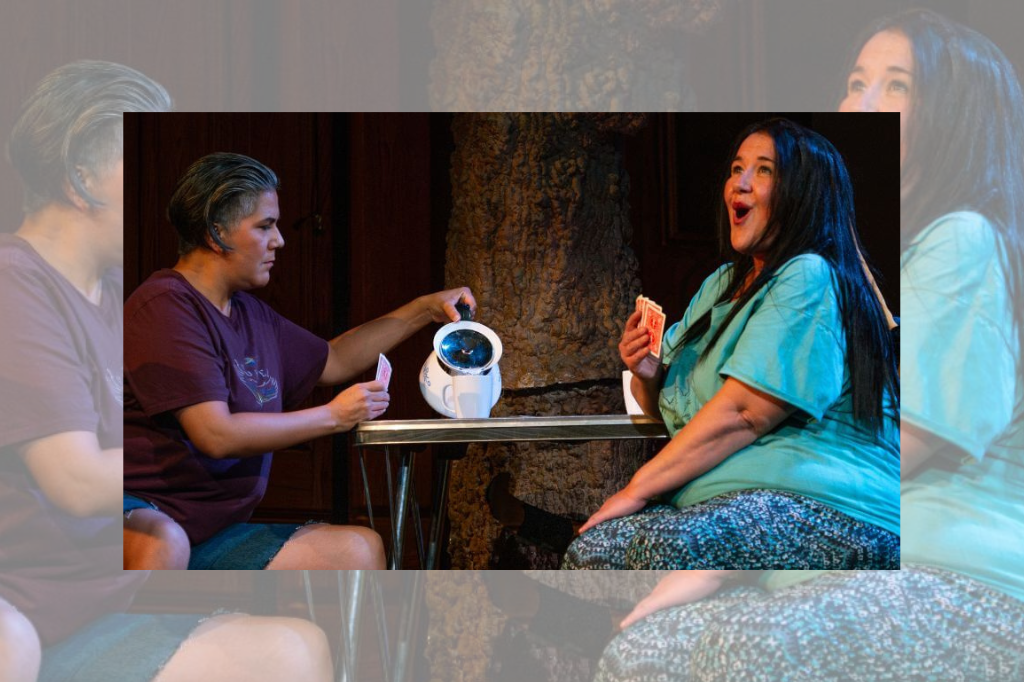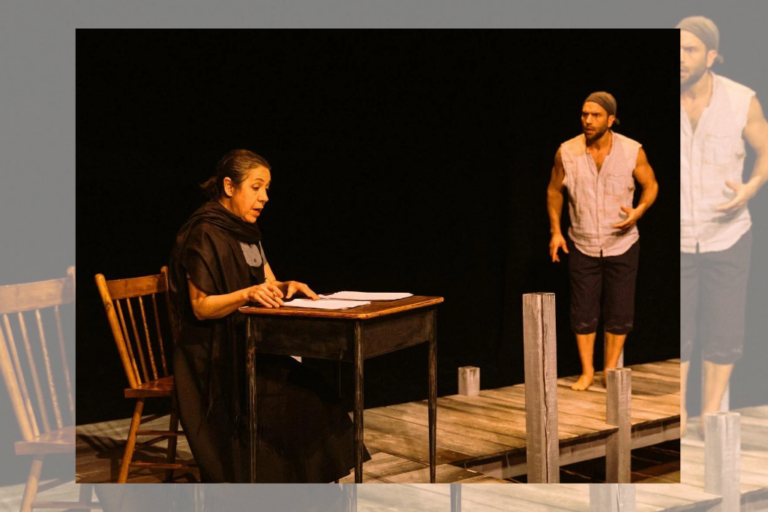REVIEW: CANOE brings mystical, operatic flair to Canada’s dark history
Content warning: this review contains mention of residential schools.
Through a minimalist aesthetic and a score that blends classical music with non-conventional elements, CANOE presents a mystical, yet deeply personal portrayal of two sisters grappling with Canada’s dark history.
It’s the 1980s, and Agent Orange testing from the nearby military base has destroyed all vegetation, leaving behind a sole birch tree. Through this isolation from the rest of the world, sisterly tensions boil inside their remote Northern Ontarian home.
The audience first meets Gladys (Nicole Joy-Fraser) and Constance (Kristine Dandavino) when the former pulls out a chainsaw and cuts down the lone birch tree. When finding out that this was their spiritual family tree, I initially found myself frustrated with Gladys’ nihilistic point-of-view.
However, through the sisters’ distinct perceptions of the same memories, it becomes clear why they act the way they do. Gladys spent her childhood in a residential school, while their grandmother was able to protect Constance from the same fate. This leads to Gladys’ resentment of her family, her home, and even the spiritual tree that reminds her of both.
Joy-Fraser and Dandavino bring a distinct aural dichotomy to the singers, encapsulating their dynamic with complementary vocal textures. Gladys is rarely angry, instead opting for nonchalance and passion-aggression. There is even an entire song based around her using “whatever” as a response to everything. Constance, although kinder, is more confrontational. When together, Gladys sings low and gentler while Constance frequently hits piercing high notes. Even when the characters shield their emotions with their words, the music reveals what’s lying underneath.
My main qualm with CANOE is that I wish it was longer. It isn’t until the second act that the human world and spirit world collide, leading to exciting interactions between the cast of four. As entertaining as the second act was, I found myself wanting even ten more minutes to explore this new world.
A standout performance for me is mezzo-soprano Michelle Lafferty as Debaajimod, the all-knowing, all-powerful storyteller. I was captivated by her soaring vocals as she explained the creation of the Brother Spirits placed inside the two sisters. With the important task of weaving together the magic and realism of the story, Lafferty’s warm portrayal draws you in from the top of the show and has you laser-focused every moment she steps back on stage.
Costume designer Sherri Hay and hair and makeup artist Deandra Wells further elevate Debaajimod. The combination of her high ponytail and even higher platform boots leaves her towering over the rest of the cast, allowing the characters to physically and spiritually look up to her.
Since Debaajimod is such a wise and powerful character, I found her dynamic with Tree Spirit (Cinlin Delbaere-Sawchuk) to be especially endearing. Tree Spirit, who thinks they are just a mere birch tree, is childlike, innocent, and maybe not the brightest. When paired with Debaajimod, and eventually the sisters, Tree Spirit’s interactions bring a lot of humor to an overall quite serious show.
With a cast of four, a band of five, simple set and costumes, and no props, CANOE is not what most people might imagine when thinking of opera. By performing in the Trinity St. Paul Centre created an intimate setting where these minimalist aesthetics could thrive.
One of the highlights of CANOE is a duet titled “Cut From the Same Cloth” in which Joy-Fraser and Dandavino’s vocals and the five-piece band really shine. This moment between the sisters is violently tense, but also intimate, with the two of them recounting their childhood trauma.
As the personal resentments turn into violence, the vocal dynamic of the sisters completely shifts. Constance’s final high note feels like a scream, while Gladys’s usually lower, gentler voice fights back with an even greater intensity. The venue captures the intimacy and tension of their home, allowing the instruments to strike the audience with the characters’ pain.
I especially enjoyed how the wooden instruments blended right into the wooden set (designed by Lindy Kinoshameg), with everything ultimately blending into the Trinity St. Paul Centre itself. Through the church structures’ dim lighting in the foreground of the set, it served as an eerie reminder of Gladys’s trauma from the residential school.
Although there were times when I found the lyrics a bit too simplistic, overall this may have made the production more accessible to audience members who may be new to opera. Whenever any productions are fully sung-through, I tend to miss some of the plot. However, with the conversational lyricism between the sisters and the narration from Debaajimod, it was easy to follow the entire story from start to finish.
CANOE closed on September 16th after a short run, but I’m excited to see how the duo behind Unsettled Scores continues to experiment with what opera can be and what stories it can tell.
Intermission reviews are independent and unrelated to Intermission’s partnered content. Learn more about Intermission’s partnership model here.












Comments